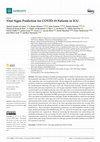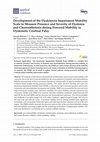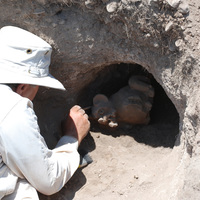Papers by Jean-Marie Aerts

VO2 kinetics provide information about the ability to respond to the increased energetic demand d... more VO2 kinetics provide information about the ability to respond to the increased energetic demand during a constant work rate test (CWRT). Typically, kinetic features that describe the phase II VO2 response (see figure), such as time constant (TC) and mean response time (MRT), are estimated using exponential models. Box-Jenkins transfer function (BJ-TF) models can extract the same features without being affected by unwanted noise contributions (e.g. phase I or measurement noise). This is realised by separately modelling phase II (system model) and unwanted contributions (noise model). We compared model fits and estimated kinetic feature values between exponential models and BJ-TF models. Both models were used to extract kinetic features from CWRT data of 18 COPD patients (14 male; age: 63 ± 7 years; FEV1: 48 ± 14 %predicted). The BJ-TF full models (illustrated in the figure for one patient, black dashed line) could accurately model the total VO2 response for all patients. Furthermore, the BJ-TF system models (orange full line), in contrast to the exponential models (grey dotted line), were able to surpass the unwanted phase I contribution, leading to more accurate TC (54 ± 23s vs 80 ± 59s; p

Applied sciences, Jun 27, 2019
The number of overweight people reached 1.9 billion in 2016. Lifespan decrease and many diseases ... more The number of overweight people reached 1.9 billion in 2016. Lifespan decrease and many diseases have been linked to obesity. Efficient ways to monitor and control body weight are needed. The objective of this work is to explore the use of a model predictive control approach to manage bodyweight in response to energy intake. The analysis is performed based on data obtained during the Minnesota starvation experiment, with weekly measurements on body weight and energy intake for 32 male participants over the course of 27 weeks. A first order dynamic auto-regression with exogenous variables model exhibits the best prediction, with an average mean relative prediction error value of 1.01 ± 0.02% for 1 week-ahead predictions. Then, the performance of a model predictive control algorithm, following a predefined bodyweight trajectory, is tested. Root mean square errors of 0.30 ± 0.06 kg and 9 ± 3 kcal day −1 are found between the desired target and simulated bodyweights, and between the measured energy intake and advised by the controller energy intake, respectively. The model predictive control approach for bodyweight allows calculating the needed energy intake in order to follow a predefined target bodyweight reference trajectory. This study shows a first possible step towards real-time active control of human bodyweight.
Applied sciences, Jan 6, 2023
This article is an open access article distributed under the terms and conditions of the Creative... more This article is an open access article distributed under the terms and conditions of the Creative Commons Attribution (CC BY
Volleyball is characterised by intervals of high-intensity gameplay mixed with periods of relativ... more Volleyball is characterised by intervals of high-intensity gameplay mixed with periods of relative rest. Monitoring the athletes' physiology during competition allows us to study the changes in exercise intensity throughout a game. In this study, eight elite male volleyball athletes measured their heart rate and activity during multiple games of the regular season in the Belgian Liga A and B using wearable technology. The data show a significant decrease in the heart rate for set 1 to 4, from 79.1 %HRmax to 73.9 %HRmax. For activity, a decreasing trend is visually observed, but the difference is only significant for set 1 compared to the other sets. Finally, the performance did not vary significantly over the course of the different sets.

International Journal of Sports Physiology and Performance, Apr 1, 2022
Purpose: The aim of this study was to identify the relationships between continuously measured in... more Purpose: The aim of this study was to identify the relationships between continuously measured internal and external load variables during volleyball competition. Methods: A total of 8 male elite volleyball athletes (Belgian Liga A and Liga B) were monitored during official competition matches. In total, 63 individual measurements are included in this study. The authors used heart-rate (HR) data as internal load and accelerometer-based activity as external load. Data were recorded at a sampling frequency of 1 Hz using wearable technology during official competition. Workload during continuous game play and individual jumps performed while serving and spiking (selected by means of video analysis) were studied using correlation analysis and dynamic time-series modeling. Results: Significant linear correlations were observed between peak acceleration and maximal HR of individual serves (ρ = .62; P = 1.6e−5) and spikes (ρ = .49; P = 1.2e−3) that were performed during the warm-up. These same actions performed during the match did not show significant correlations. The correlation between the mean HR and mean activity throughout the entire match was also found to be significant (ρ = .67; P = 2.0e−9). With respect to the time-series models, the mean value for the goodness of fit () between HR and activity was equal to .83 and .67 for the individual actions and the entire matches, respectively. Conclusions: The results show that there are strong relationships between internal and external load during volleyball competition. Second-order transfer function models are capable of explaining the main dynamics of HR (internal load) in response to accelerometer-based activity (external load). Time-series analysis of continuously measured workload is proposed for use in practice.

Background: Previous work demonstrated the possibility to automate pulmonary function test interp... more Background: Previous work demonstrated the possibility to automate pulmonary function test interpretation to diagnose respiratory disease using machine learning (ML). Since ML is a black box approach, understanding the reasoning behind a prediction is critical for generating trust, and is fundamental if one plans to take action based on a prediction. Objectives: We investigated a technique called locally interpretable model-agnostic explanation (LIME) to explain the predictions of a ML classifier that takes PFT data (spirometry, resistance, lung volumes, diffusion capacity) as input to suggest a diagnosis. Methods: We developed a ML classifier using 1400 historical cases. We tested our classifier in 50 randomly selected subjects with respiratory problems who completed PFT. An expert panel produced gold standard diagnoses from clinical, PFT and other test data. We applied LIME technique to generate interpretative explanations for each classifier prediction. Results: The classifier accuracy was 76%. LIME showed a high FEV1 Z-score (0.41±0.71) and TLCO%pred (92±15%) as the top explanatory feature for normal and asthma prediction while a low FEV1/FVC (50±11%) and RV%pred (70±15%) for COPD and ILD prediction respectively. Three predictions were incorrect when the top feature was negative (Fig 1b). Conclusion: By providing intuitive explanations, LIME builds trust for clinical application of a ML-based PFT interpretation algorithm.

Biological systems have the ever-intriguing capacity to deal with disturbances and challenges fro... more Biological systems have the ever-intriguing capacity to deal with disturbances and challenges from their environment. Exercise and sports are no different when it comes to studying systems (i.e. the human body) under stress. The goal of this study is to model the dynamic responses of heart rate (HR) and oxygen uptake (⩒O2) during incremental exercise tests, and identify changes in the characteristic response time and amplitude gain. Therefore, we study data of 992 maximal effort running tests from an open access dataset. First order autoregressive-exogenous (ARX) models with time-varying parameters accurately fit the data (R² > 0.98) and indicate overall faster dynamics for ⩒O2 in comparison to HR. Furthermore, the models demonstrate significant slowing down of these dynamics at exhaustion and during the first moments of recovery for both physiological variables. In addition, the (steady state) gain values for HR and ⩒O2 decrease from start to end of the test. Finally, small but ...
Proceedings of the 4th International Congress on Sport Sciences Research and Technology Support
Car racing at a high level is a physically and mentally intensive sport. Despite the fact that a ... more Car racing at a high level is a physically and mentally intensive sport. Despite the fact that a large number of variables are measured on the car during racing, nothing is measured on the driver. It is well known that to achieve peak performance in competitive sports it is important that the athlete is at their peak both physically and mentally. The objective of this work is to monitor the mental state of the driver in real-time and provide this information to the pit crew. A number of interesting cases are presented that show the potential of realtime stress monitoring in race car driving as a means for driver performance optimisation and as a means to reduce accidents.

Sensors
This study introduces machine learning predictive models to predict the future values of the moni... more This study introduces machine learning predictive models to predict the future values of the monitored vital signs of COVID-19 ICU patients. The main vital sign predictors include heart rate, respiration rate, and oxygen saturation. We investigated the performances of the developed predictive models by considering different approaches. The first predictive model was developed by considering the following vital signs: heart rate, blood pressure (systolic, diastolic and mean arterial, pulse pressure), respiration rate, and oxygen saturation. Similar to the first approach, the second model was developed using the same vital signs, but it was trained and tested based on a leave-one-subject-out approach. The third predictive model was developed by considering three vital signs: heart rate (HR), respiration rate (RR), and oxygen saturation (SpO2). The fourth model was a leave-one-subject-out model for the three vital signs. Finally, the fifth predictive model was developed based on the sa...

AimDyskinetic cerebral palsy (DCP) is characterised by involuntary movements, and the movement pa... more AimDyskinetic cerebral palsy (DCP) is characterised by involuntary movements, and the movement patterns of children with DCP have not been extensively studied during upper limb tasks. The aim of this study is to evaluate psychometric properties of upper limb kinematics in participants with DCP and typically developing (TD) participants.MethodsTwenty TD participants and 20 participants with DCP performed three functional tasks: reaching forward, reach and grasp vertical and reach sideways during three-dimensional motion analysis. Joint angles at point of task achievement (PTA) and spatio-temporal parameters were evaluated within-and between sessions using intra-class correlation coefficients (ICC) and standard error of measurement (SEM). Independent t-tests/Mann-Whitney U tests were used to compare all parameters between groups.ResultsWithin-session ICC values ranged from 0.55 to 0.99 for joint angles at PTA and spatio-temporal parameters for both groups during all tasks. Within-sess...

The thermal effects related to wearing a bicycle helmet are complex and different studies have in... more The thermal effects related to wearing a bicycle helmet are complex and different studies have investigated single parts of this topic. A literature review was produced and published (Bogerd et al., 2015) summarizing the different findings to give a complete overview on this topic as well as to suggest new perspectives. Headgear increases head insulation and therefore is mainly problematic under warm conditions, which is the focus of that review. Helmets do not affect physiological parameters other than the local skin temperature and sweat rate. However, the head is among the most sensitive body parts related to thermal comfort, thereby directly affecting the willingness to wear headgear. Several methods have been used to study thermal aspects of headgear, which could be categorized as (i) numerical, (ii) biophysical, (iii) combined numerical and biophysical, and (iv) user trials. The application of these methods established that heat transfer mainly takes place through radiation an...

Journal of Applied Physiology, 2020
Kinetic features such as oxygen uptake (V̇o2) mean response time (MRT), and gains of V̇o2, carbon... more Kinetic features such as oxygen uptake (V̇o2) mean response time (MRT), and gains of V̇o2, carbon dioxide output (V̇co2), and minute ventilation (V̇e) can describe physiological exercise responses during a constant work rate test of patients with chronic obstructive pulmonary disease (COPD). This study aimed to establish simple guidelines that can identify COPD patients for whom kinetic analyses are (un)likely to be reliable and examined whether slow V̇o2 responses and gains of V̇o2, V̇co2, and V̇e are associated with ventilatory, cardiovascular, and/or physical impairments. Kinetic features were examined for 265 COPD patients [forced expiratory volume in 1 s (FEV1): 54 ± 19%predicted] who performed a constant work rate test (duration > 180 s) with breath-by-breath measurements of V̇o2, V̇co2, and V̇e. Negative/positive predictive values were used to define cutoff values of relevant clinical variables below/above which kinetic analyses are (un)likely to be reliable. Kinetic featu...
Landscape and Urban Planning, 2021
Highlights We studied residential green space exposure of 157 adults with tree pollen allergy. ... more Highlights We studied residential green space exposure of 157 adults with tree pollen allergy. Residential green space was associated with reduced mental distress and perceived stress. Allergenic tree species within 2 km distance contributed to mental distress. Residential green space exposure was associated with more severe allergy symptoms. Green space had mixed health effects during the pollination season.
Developmental Neurorehabilitation, 2020

Medicine & Science in Sports & Exercise, 2020
Purpose Not all patients with chronic obstructive pulmonary disease (COPD) experience similar ben... more Purpose Not all patients with chronic obstructive pulmonary disease (COPD) experience similar benefits after pulmonary rehabilitation (PR). This pre–post PR study used a large sample of patients with COPD to determine whether PR-induced changes of oxygen uptake (V˙O2) kinetics and exercise responses of V˙O2, carbon dioxide output (V˙CO2), minute ventilation (V˙E), V˙E/V˙CO2, breathing frequency, and tidal volume differed between responders and nonresponders to PR. Methods Responders to PR were defined as patients with a minimal clinically important increase in endurance time of 105 s. Isotime (=180 s) values of V˙O2, V˙CO2, V˙E, V˙E/V˙CO2, breathing frequency, and tidal volume; gains of V˙O2, V˙CO2, and V˙E; and V˙O2 mean response time of 183 patients with COPD (forced expiratory volume in 1 s: 56% ± 19% predicted) were compared between pre- and post-PR constant work rate tests. Results After PR, only the group of responders significantly decreased V˙O2 mean response time (P < 0....

M-health/e-health, 2019
Background: Previous work demonstrated the possibility to automate pulmonary function test interp... more Background: Previous work demonstrated the possibility to automate pulmonary function test interpretation to diagnose respiratory disease using machine learning (ML). Since ML is a black box approach, understanding the reasoning behind a prediction is critical for generating trust, and is fundamental if one plans to take action based on a prediction. Objectives: We investigated a technique called locally interpretable model-agnostic explanation (LIME) to explain the predictions of a ML classifier that takes PFT data (spirometry, resistance, lung volumes, diffusion capacity) as input to suggest a diagnosis. Methods: We developed a ML classifier using 1400 historical cases. We tested our classifier in 50 randomly selected subjects with respiratory problems who completed PFT. An expert panel produced gold standard diagnoses from clinical, PFT and other test data. We applied LIME technique to generate interpretative explanations for each classifier prediction. Results: The classifier accuracy was 76%. LIME showed a high FEV1 Z-score (0.41±0.71) and TLCO%pred (92±15%) as the top explanatory feature for normal and asthma prediction while a low FEV1/FVC (50±11%) and RV%pred (70±15%) for COPD and ILD prediction respectively. Three predictions were incorrect when the top feature was negative (Fig 1b). Conclusion: By providing intuitive explanations, LIME builds trust for clinical application of a ML-based PFT interpretation algorithm.

Processes, 2019
Conventional indoor climate design and control approaches are based on static thermal comfort/sen... more Conventional indoor climate design and control approaches are based on static thermal comfort/sensation models that view the building occupants as passive recipients of their thermal environment. Recent advances in wearable sensing technologies and their generated streaming data are providing a unique opportunity to understand the user’s behaviour and to predict future needs. Estimation of thermal comfort is a challenging task given the subjectivity of human perception; this subjectivity is reflected in the statistical nature of comfort models, as well as the plethora of comfort models available. Additionally, such models are using not-easily or invasively measured variables (e.g., core temperatures and metabolic rate), which are often not practical and undesirable measurements. The main goal of this paper was to develop dynamic model-based monitoring system of the occupant’s thermal state and their thermoregulation responses under two different activity levels. In total, 25 partici...

Applied Sciences, 2019
The majority of individuals with dyskinetic cerebral palsy cannot use powered mobility with a joy... more The majority of individuals with dyskinetic cerebral palsy cannot use powered mobility with a joystick, due to the lack of manual abilities by the severe presence of dystonia and choreoathetosis. Reliable measurements of these movement disorders is indispensable for good evaluation towards evidence–based insights during powered mobility. This study aimed to develop and assess the Dyskinesia Impairment Mobility Scale (DIMS), a video–based tool to measure presence and severity of dystonia and choreoathetosis during powered mobility. DIMS was measured for the neck and arms region during five mobility tasks. Interrater reliability, test–retest reliability, internal consistency and concurrent validity of the DIMS were assessed. Interrater reliability coefficients ranged between 0.68 and 0.87 for the total DIMS, and the dystonia and choreoathetosis subscales. Test–retest reliability was moderate to excellent (range 0.51–0.93) while Cronbach’s alpha was good (range 0.69–0.81) for the total...

International Journal of Chronic Obstructive Pulmonary Disease, 2019
Background: Severe hyperinflation causes detrimental effects such as dyspnea and reduced exercise... more Background: Severe hyperinflation causes detrimental effects such as dyspnea and reduced exercise capacity and is an independent predictor of mortality in COPD patients. Static lung volumes are required to diagnose severe hyperinflation, which are not always accessible in primary care. Several studies have shown that the area under the forced expiratory flow-volume loop (AreaFE) is highly sensitive to bronchodilator response and is correlated with residual volume/ total lung capacity (RV/TLC), a common index of air trapping. In this study, we investigate the role of AreaFE% (AreaFE expressed as a percentage of reference value) and conventional spirometry parameters in indicating severe hyperinflation. Materials and methods: We used a cohort of 215 individuals with COPD. The presence of severe hyperinflation was defined as elevated air trapping (RV/TLC .60%) or reduced inspiratory fraction (inspiratory capacity [IC]/TLC ,25%) measured using body plethysmography. AreaFE% was calculated by integrating the maximal expiratory flow-volume loop with the trapezoidal rule and expressing it as a percentage of the reference value estimated using predicted values of FVC, peak expiratory flow and forced expiratory flow at 25%, 50% and 75% of FVC. Receiver operating characteristics (ROC) curve analysis was used to identify cutoffs that were used to indicate severe hyperinflation, which were then validated in a separate group of 104 COPD subjects. Results: ROC analysis identified cutoffs of 15% and 20% for AreaFE% in indicating RV/ TLC .60% and IC/TLC ,25%, respectively (N=215). On validation (N=104), these cutoffs consistently registered the highest accuracy (80% each), sensitivity (68% and 75%) and specificity (83% and 80%) among conventional parameters in both criteria of severe hyperinflation. Conclusion: AreaFE% consistently provides a superior estimation of severe hyperinflation using different indices, and may provide a convenient way to refer COPD patients for body plethysmography to address static lung volumes.











Uploads
Papers by Jean-Marie Aerts